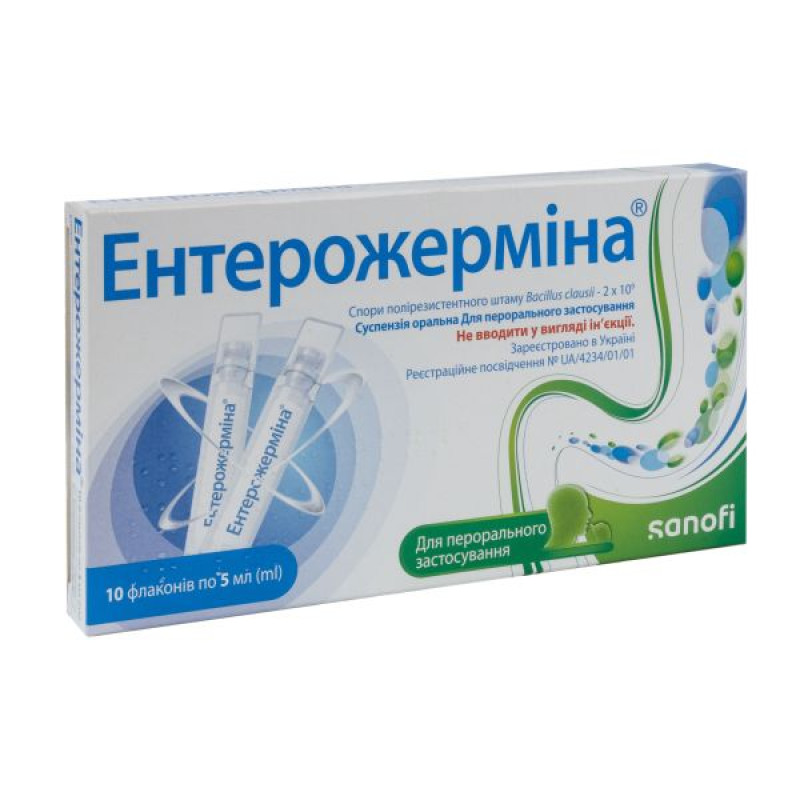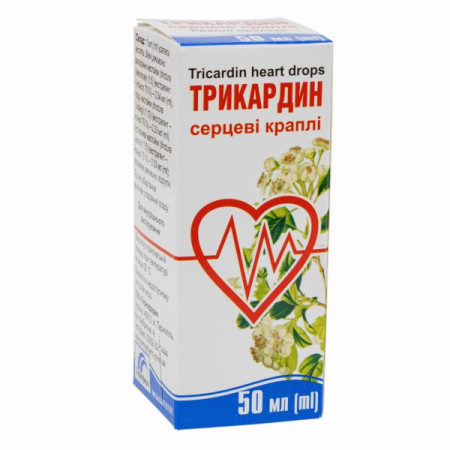Enterogermina oral suspension bottle 5 ml No. 10

Instructions for Enterogermina oral suspension, bottle 5 ml, No. 10
Composition
active ingredient: 1 bottle of 5 ml contains spores of the multi-resistant strain Bacillus clausii - 2 × 109;
excipient: purified water.
Dosage form
Oral suspension.
Main physicochemical properties: opalescent whitish liquid, which may have a characteristic odor.
Pharmacotherapeutic group
Antidiarrheal microbial drugs.
ATX code A07 FA.
Pharmacological properties
Pharmacodynamics.
The drug EnterogerminaÒ is a suspension of spores of 4 strains (SIN, O/C, T, N/R) of Bacillus clausii, which are normally present in the intestines and do not exhibit pathogenic activity.
The spores are inherently heat and gastric acidity tolerant. In a validated in vitro model, Bacillus clausii spores have been shown to survive in a gastric model (pH 1.4–1.5) for up to 120 minutes (96% survival rate). In a gut model (bile and pancreatin saline, pH 8), Bacillus clausii spores have been shown to multiply significantly above their initial numbers (109 to 1012 colony-forming units (CFU)) starting at 240 minutes after incubation. In a study of 20 subjects, Bacillus clausii spores were found to persist in the human gut and can be detected in feces for up to 12 days after a single oral dose.
Thanks to the action of Bacillus clausii, the drug restores the intestinal microflora altered as a result of drug therapy that leads to dysbacteriosis (also known as dysbiosis), which can also be associated with gastrointestinal symptoms such as diarrhea, abdominal pain and flatulence (bloating). In addition, due to the ability of Bacillus clausii to synthesize various vitamins, especially those of group B, the drug contributes to the correction of vitamin deficiency caused by the use of antibiotics or chemotherapeutic drugs. Due to the metabolic activity of Bacillus clausii, the use of the drug allows you to achieve a non-specific antigenic and antitoxic effect.
Due to their high resistance to chemical and physical agents, Bacillus clausii spores pass intact through the gastric juice barrier into the intestinal tract, where they transform into metabolically active vegetative cells.
In two open, randomized, controlled clinical trials, the drug Enterogermina® demonstrated a reduction in the duration of acute diarrhea in children aged 6 months and older.
When taken during antibiotic treatment and for the following 7–10 days, Enterogermina® has been shown to reduce the incidence of abdominal pain and diarrhea associated with antibiotic treatment.
The 2 main properties of Bacillus clausii listed below contribute to the restoration of intestinal bacterial flora.
Inhibition of the growth of pathogenic bacteria
Three possible mechanisms of action of B. clausii are: colonization of vacant ecological niches, which prevents the growth of other microorganisms; competition for attachment to epithelial cells, which is especially true for spores in the initial and intermediate stages of germination; production of antibiotics and/or enzymes that are secreted into the intestinal environment. In vitro studies have shown that spores of Bacillus clausii produce bacteriocins and antibiotics, such as clausin, with antagonistic activity against the gram-positive bacteria Staphylococcus aureus, Clostridium difficile, and Enterococcus faecium.
Immunomodulatory activity
Orally administered Bacillus clausii spores have been shown to stimulate interferon-gamma production and increase CD4+ T-lymphocyte proliferation in in vitro and in vivo mouse models.
Pharmacokinetics.
The drug does not interact with the following antibiotics: penicillin when used not in combination with beta-lactamase inhibitors, cephalosporins (partial resistance in most cases), tetracyclines, macrolides, aminoglycosides (except gentamicin and amikacin), chloramphenicol, thiamphenicol, lincomycin, clindamycin, isoniazid, cycloserine, novobiocin, rifampicin, nalidixic acid and pipemidic acid (intermediate resistance), metronidazole.
In addition, due to the ability of Bacillus clausii to synthesize various vitamins, especially group B, the drug helps correct vitamin deficiencies caused by the use of antibiotics or chemotherapeutic drugs.
Indication
Treatment and prevention of intestinal dysbacteriosis and associated endogenous dysvitaminosis.
Therapy aimed at restoring normal intestinal microflora, which is disrupted during treatment with antibiotics or chemotherapeutic drugs.
Acute and chronic gastrointestinal diseases associated with intoxication or intestinal dysbacteriosis and dysvitaminosis in infants who are fed breast milk.
Contraindication
Hypersensitivity to the active substance or to any of the excipients of the drug.
Interaction with other medicinal products and other types of interactions
There is no data on the interaction of the drug with other medicines.
Application features
The bottle should be shaken before use.
The drug has a high degree of heterologous resistance to antibiotics, which allows it to be used both for the prevention of changes in the intestinal microflora caused by the selective action of antibiotics (especially broad-spectrum antibiotics), and for the restoration of an already disturbed balance of the intestinal microflora.
If the drug is prescribed simultaneously with antibiotics, it should be used between two doses of the antibiotic.
This medicine is for oral use only. It should not be administered by injection or any other route. Incorrect use of this medicine has resulted in severe anaphylactic reactions such as anaphylactic shock.
Bacteremia and sepsis
During post-marketing use, cases of bacteremia, septicemia and sepsis have been observed in immunocompromised or critically ill patients, as well as in premature infants. In some patients in critical condition, the outcome was fatal. Enterogermina® should be avoided in these patient groups (see section "Adverse reactions").
Use during pregnancy or breastfeeding
Pregnancy. Available data on the use of Enterogermin® capsules in pregnant women are limited, therefore no conclusion can be drawn regarding the safety of the drug during pregnancy.
The drug Enterogermina® can be used during pregnancy only if the potential benefit to the pregnant woman outweighs the potential risks, including the risks to the fetus.
Breastfeeding. Available data on the use of Enterogermin® capsules during lactation, namely on the presence of the drug in breast milk and the effect on the infant, are limited, therefore no conclusions can be drawn regarding the safety of the drug during breastfeeding.
The drug Enterogermina® can be used during breastfeeding only if the potential benefit to the mother outweighs the potential risks, including the risks to the breastfed child.
Fertility. There are no data on the effect of the drug Enterogermin® on human fertility.
Ability to influence reaction speed when driving vehicles or other mechanisms
Does not affect.
Method of administration and doses
Adults – 1 vial 2–3 times a day; children aged 28 days to 18 years – 1 vial 1–2 times a day.
The duration of treatment is determined by the doctor depending on the patient's condition and the course of the disease.
The suspension should be taken at regular intervals (3–4 hours). Shake the contents of the bottle before use and take undiluted or dilute in water or other liquid (milk, tea, orange juice).
The presence of visible particles in the vial (due to spore aggregation) does not affect the quality of the product.
This medicine is for oral use only. It should not be administered by injection or any other method.
Children
The drug can be used in children from 28 days of age.
Overdose
To date, there have been no reports of clinical manifestations of overdose with this drug.
Adverse reactions
Adverse reactions observed during the use of the drug Enterogermina® are listed below according to the classification of organ systems and frequency of occurrence: very common (≥ 1/10); common (≥ 1/100, < 1/10); uncommon (≥ 1/1000, < 1/100); rare (≥ 1/10,000, < 1/1000); very rare (< 1/10,000); frequency unknown (cannot be estimated from the available data).
Skin and subcutaneous tissue disorders
Frequency unknown: hypersensitivity reactions, including rash, urticaria and angioedema.
Infectious and parasitic diseases
Frequency not known: bacteremia, septicemia and sepsis (in immunocompromised or critically ill patients) (see section 4.4).
Reporting of suspected adverse reactions
Reporting adverse reactions after the registration of a medicinal product is important. This allows monitoring of the benefit/risk ratio when using this medicinal product. Medical and pharmaceutical professionals, as well as patients or their legal representatives, should report all cases of suspected adverse reactions and lack of efficacy of the medicinal product via the Automated Information System for Pharmacovigilance at the link: https://aisf.dec.gov.ua.
Expiration date
2 years.
Storage conditions
Store out of the reach of children at a temperature not exceeding 30 ºС.
To avoid contamination of the suspension, do not open the vial in advance.
Packaging
No. 10; No. 20 (10 × 2): 5 ml in a vial; 10 vials, interconnected by a polyethylene jumper, in a cassette; 1 or 2 cassettes in a cardboard box.
Vacation category
Without a prescription.
Producer
UNITER LABORATORIES, France.
or
Opella Healthcare Italy S.r.l., Italy.
Location of manufacturers and addresses of their places of business
Zi de la Gery 50211, COUTANCES Cedex, France.
or
Viale Europa, 11 – 21040 Origgio (VA), Italy.
Applicant
Location of the applicant and its business address
Ukraine, 01033, Kyiv, Zhylyanska St., 48-50A.
There are no reviews for this product.
There are no reviews for this product, be the first to leave your review.
No questions about this product, be the first and ask your question.











